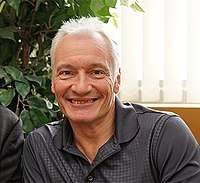Dirk De Ridder (neurosurgeon)
Dirk De Ridder (born 6 August 1966) is a Belgian neurosurgeon. He is currently the Neurological Foundation Professor of Neurosurgery at the University of Otago in Dunedin, New Zealand.[1] De Ridder spends half his time in New Zealand and half in Belgium, involved in setting up a dedicated neuromodulation clinic.
| Dirk De Ridder | |
|---|---|
 | |
| Born | 6 August 1966, Gent, Belgium |
| Residence | Dunedin, New Zealand |
| Alma Mater | University of Gent, Belgium |
| Known for | Experiemental neurosurgery, brain implants, non-invasive neuromodulation |
| Scientific career | |
| Fields | Neurosurgery, Neuroscience |
| Institution | University of Otago |
Education
De Ridder was born and raised in Ghent, Belgium, in an academic family, with both his parents being University professors. As a child, he spent almost a year in Rwanda during primary school as well as a medical trainee later, and a year in the USA in high school.
De Ridder obtained his MD at the University of Gent, Belgium in 1992 and PhD (A Darwinian neurosurgical approach to tinnitus) at the University of Antwerp in Belgium. He lived and worked for a year in South Africa, after which he worked for 12 years at the University Hospital Antwerpen in Antwerp, Belgium. He has lived in New Zealand since 2013 with his two sons.
Research
De Ridder has published over 250 scientific articles, more than 30 scientific book chapters and several articles for a wider audience. His main research topic is the understanding and treatment of phantom perceptions such as pain[2] and tinnitus,[3][4] as well as addiction, using non-invasive neuromodulation (TMS, tDCS, tACS, tRNS, tPNS, neurofeedback) and especially invasive neuromodulation techniques such as brain implants. The focus of his research is to understand the common mechanisms of different diseases such as pain, tinnitus, Parkinson’s Disease, depression and slow wave epilepsy, a group of diseases known as ‘thalamocortical dysrhythmias’.[5] His research also focuses on addiction, obsessive compulsive disorder, impulsive and personality disorders, an entity called ‘reward deficiency syndromes’. His work and research is strongly influenced by the philosophers Aristotle and Merleau-Ponty, the biologist Charles Darwin, the mathematician Thomas Bayes, the architect Antoni Gaudi and neuroscientists such as the late Walter Freeman III, Rodolfo Llinas and Steven Laureys. He has developed “burst” stimulation, novel stimulation design for brain and spine implants,[6] which is commercialised by Abbott as burst-DR. He is currently working on other stimulation designs such as noise stimulation and reconditioning stimulation. The philosophy of these stimulation designs is related to Antoni Gaudi’s adage of mimicking nature, i.e. by mimicking natural firing and oscillation patterns in the nervous system.
Contributions
Dirk De Ridder is recognised as the world-leading expert in tinnitus.[7] He is a strong proponent of interdisciplinary and translational neuroscience. He translates basic neuroscience into novel brain surgery techniques with clinical applications via small pilot studies looking at feasibility and initial clinical results. His interdisciplinary approach is exemplified by the fact that he has published with more than 40 different research groups worldwide. For example, his translational work includes:
- investigating microvascular decompression for abducens spasm, as well as for hemilingual spasm;
- investigating brain implants for tinnitus, on primary and secondary auditory cortex, frontal cortex, anterior cingulate cortex and amygdalohippocampal area;[8]
- investigating vagal nerve stimulation for tinnitus;
- investigating somatosensory cortex implants for deafferentation pain;
- investigating C2 implant for tinnitus, as well as for failed back surgery syndrome;
- investigating out of body experience with PET scan in a person in whom the out of body experience could be elicited by activation of a brain implant;[9]
- investigating burst stimulation clinically on auditory cortex, on spinal cord and peripheral nerve (C2 nerve)[6]
- investigating dACC implants for alcohol addiction and OCD.
References
- "DSM staff profile". www.otago.ac.nz. Retrieved 2018-07-04.
- Ridder, Dirk De; Elgoyhen, Ana Belen; Romo, Ranulfo; Langguth, Berthold (2011-05-17). "Phantom percepts: Tinnitus and pain as persisting aversive memory networks". Proceedings of the National Academy of Sciences. 108 (20): 8075–8080. doi:10.1073/pnas.1018466108. ISSN 0027-8424. PMC 3100980. PMID 21502503.
- Langguth, Berthold; Kreuzer, Peter M; Kleinjung, Tobias; De Ridder, Dirk (September 2013). "Tinnitus: causes and clinical management". The Lancet Neurology. 12 (9): 920–930. doi:10.1016/s1474-4422(13)70160-1. ISSN 1474-4422. PMID 23948178.
- Elgoyhen, Ana Belén; Langguth, Berthold; De Ridder, Dirk; Vanneste, Sven (2015-09-16). "Tinnitus: perspectives from human neuroimaging". Nature Reviews Neuroscience. 16 (10): 632–642. doi:10.1038/nrn4003. ISSN 1471-003X. PMID 26373470.
- Vanneste, Sven; Song, Jae-Jin; De Ridder, Dirk (2018-03-16). "Thalamocortical dysrhythmia detected by machine learning". Nature Communications. 9 (1): 1103. doi:10.1038/s41467-018-02820-0. ISSN 2041-1723. PMC 5856824. PMID 29549239.
- De Ridder, Dirk; Plazier, Mark; Kamerling, Niels; Menovsky, Tomas; Vanneste, Sven (September 2013). "Burst Spinal Cord Stimulation for Limb and Back Pain". World Neurosurgery. 80 (5): 642–649.e1. doi:10.1016/j.wneu.2013.01.040. ISSN 1878-8750. PMID 23321375.
- "Tinnitus: Worldwide - Expertscape.com". expertscape.com. Retrieved 2020-08-11.
- De Ridder, Dirk; Vanneste, Sven; Kovacs, Silvia; Sunaert, Stefan; Menovsky, Tomas; van de Heyning, Paul; Moller, Aage (April 2011). "Transcranial magnetic stimulation and extradural electrodes implanted on secondary auditory cortex for tinnitus suppression". Journal of Neurosurgery. 114 (4): 903–911. doi:10.3171/2010.11.jns10197. ISSN 0022-3085. PMID 21235318.
- De Ridder, Dirk; Van Laere, Koen; Dupont, Patrick; Menovsky, Tomas; Van de Heyning, Paul (September 2007). "Visualizing Out-of-Body Experience in the Brain". New England Journal of Medicine. 357 (18): 1829–1833. doi:10.1056/nejmoa070010. ISSN 0028-4793. PMID 17978291.